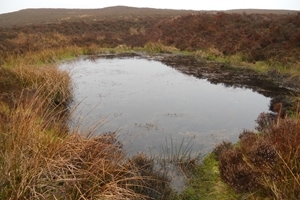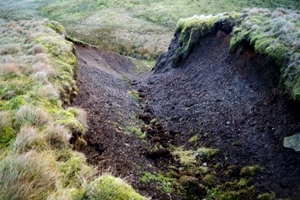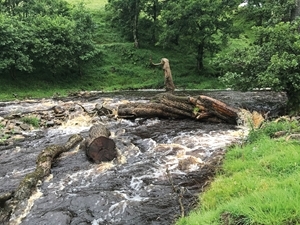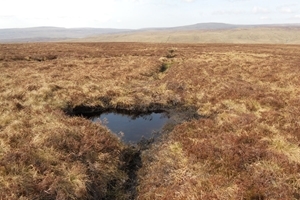 Grouse moors are often located on blanket bog peatland, which sits across upland hills like a sponge, soaking up rainwater. This water is absorbed, trickles through the peat soils and is slowly released into streams and rivers flowing towards lowland areas. This means that how these blanket bogs are managed is important for water quality and flow.
Grouse moors are often located on blanket bog peatland, which sits across upland hills like a sponge, soaking up rainwater. This water is absorbed, trickles through the peat soils and is slowly released into streams and rivers flowing towards lowland areas. This means that how these blanket bogs are managed is important for water quality and flow.
In general, a healthy bog is a wet, low-oxygen environment, where plant matter cannot break down and the carbon within it is captured and stored as peat before it decomposes. However, when a bog dries out, oxygen from the air can come into contact with dead plant matter – leading to decomposition and carbon release.
The main impacts of moorland management for water come from drainage, with the potential effects of managed heather burning still being investigated. Drainage was carried out after the war in response to government incentives hoping to increase the productivity of these upland areas for livestock – not, as is often suggested, for grouse. It has since become clear that draining peatlands is very damaging, and many grouse moor and other upland land managers have been blocking the drains that remain in order to rewet their moorland. The possible impacts of managed heather burning on water quality and flood risk management are not clear and research is ongoing. It is important to be clear about the difference between managed heather burning and wildfire, the damaging effects of which are well established.
Water quality
 The impact that managed heather burning may have on water quality is still being studied, with different pieces of evidence suggesting different effects. Some commonly cited evidence suggests that burning may be associated with increased water colour, with some papers equating this to an increase in dissolved organic carbon (DOC). However, one study showed that DOC did not rise in response to burning, and the colour of water is not always a good indicator of DOC. Several more recent studies examining water colour have found that managed burning has no effect.
The impact that managed heather burning may have on water quality is still being studied, with different pieces of evidence suggesting different effects. Some commonly cited evidence suggests that burning may be associated with increased water colour, with some papers equating this to an increase in dissolved organic carbon (DOC). However, one study showed that DOC did not rise in response to burning, and the colour of water is not always a good indicator of DOC. Several more recent studies examining water colour have found that managed burning has no effect.
The impact on water quality is not fully understood because results differ depending on both the length of time since burning, and the scale at which the studies are performed. Effects may be different at smaller, local scales, compared to the larger, catchment or landscape scales, as well as variations at different times since burning. To further complicate the picture, there may also be short term changes in water coloration in response to heavy rainfall, where streams becomes more intensely coloured after rain events regardless of management. The possible effect of burning on water quality and amount of run-off is also complicated by interactions with other upland management, such as woodland expansion and grazing. These interactions have not yet been well studied.
Flood risk
 The evidence base regarding a possible impact of prescribed burning on flood risk is limited and still inconclusive. Although there are relatively few studies available, the authors of a 2013 Natural England report could not find any evidence that burning increases flood risk, and state that: “No evidence was identified specifically relating to the effect of burning on watercourse flow or the risk of downstream flood events. If there are any effects, these are likely to be highly site specific”.
The evidence base regarding a possible impact of prescribed burning on flood risk is limited and still inconclusive. Although there are relatively few studies available, the authors of a 2013 Natural England report could not find any evidence that burning increases flood risk, and state that: “No evidence was identified specifically relating to the effect of burning on watercourse flow or the risk of downstream flood events. If there are any effects, these are likely to be highly site specific”.
The EMBER study, also published in 2013, examined the effect of rotational burning on deep blanket peat sites and drew several conclusions. These include that the lag time to peak runoff is increased on burnt sites for most rain conditions – meaning that the movement of water is slowed down across areas managed with burning – but that for the heaviest of storms, although the lag time is the same, the peak flow is higher from burnt compared to unburnt catchments.
The explanation suggested for these seemingly contradictory finding is that in this study, water tables were found to be lower on sites managed with burning so more water could be absorbed into the peat during rain events and this slowed down water flow. However, when rain was very heavy and the peat became ‘full’ of water, any excess then ran across the surface, which was less rough on burned areas so the surface flow moved more quickly, leading to higher peaks. Although this study is often cited, there are flaws in the experimental design and the findings have been questioned by other academics.
Many studies have been done in this field recently, with some pieces of evidence seeming contradictory, so Natural England and the Moorland Association commissioned an update looking at evidence from 2013-2020, which was published earlier this year. For water quality and flow, this review finds that managed burning has no impact on water colour, but that the evidence is conflicting for pH (acidity). Managed burning may increase the likelihood of water flow across the surface, but the evidence is not robust, nor is it consistent for any possible effect on water table depth or stream flow.
A research project carried out for Defra and published earlier this year compared managed burning with cutting for heather management over a four-year time period, and found that in areas managed with cutting, more rainwater was absorbed, the water table was closer to the surface and less water drained off the peatland into nearby streams and rivers, compared to areas managed with burning. This may have implications for river flow and flooding downstream. To better understand these complex questions, the studies designed to address them have to be long-term, extending at least for the duration of a complete management cycle. This year’s study for Defra reported phase 1: preliminary findings from the first five years of a study, which continues in phase 2 for at least another five years.
Research is ongoing to better understand this complex topic, sometimes raising as many questions as it answers.
Impact of drainage
 Moorlands have been drained for centuries, often to enable peat cutting for fuel, but the extent and intensity of drainage increased from the 1950s to the 1980s. During this time, government subsidies were paid to landowners for digging drainage ditches (known in some places as ‘grips’). Drainage was intended to lower the water table on moorland primarily for agricultural purposes, to improve grazing for livestock, as part of the post-war drive for “more food from our own resources”. In the same era, large areas of British moorland were drained for commercial forestry. Woodland planting on the hill and hill edge continues to affect upland landscapes, habitat, and water.
Moorlands have been drained for centuries, often to enable peat cutting for fuel, but the extent and intensity of drainage increased from the 1950s to the 1980s. During this time, government subsidies were paid to landowners for digging drainage ditches (known in some places as ‘grips’). Drainage was intended to lower the water table on moorland primarily for agricultural purposes, to improve grazing for livestock, as part of the post-war drive for “more food from our own resources”. In the same era, large areas of British moorland were drained for commercial forestry. Woodland planting on the hill and hill edge continues to affect upland landscapes, habitat, and water.
It is often incorrectly stated that moor owners drained the moors for grouse shooting and that this practice continues. In fact, many grouse moor owners have contributed to blocking up these drains in recent years, thereby rewetting the landscape. This can be beneficial for grouse, as their chicks feed on insects emerging from these wet areas. The Moorland Association has reported an estimate by Natural England that around 18,000 hectares of moorland habitat on grouse moors has been restored in this way across northern England. Similar schemes and activity are underway in Scotland.
Upland drainage has been associated with several negative impacts on water. These include affecting the flow of water over and through the soil, increases in the rate at which water runs off the moor into rivers during rainstorms, greater sediment flow into river systems and increased colouration of water from the peat. Levels of DOC in water running off the moor have shown to be significantly higher on drained slopes.
There is good evidence that drain blocking is an effective way to reduce the amount of sediment reaching the stream and river network. Drains dammed at intervals along their length have been shown to have low sediment levels. Blocking has also been shown to reduce colouration by 60-70% compared with a drained site. Drain blocking generally reduces peak flows of water from peatlands, but this depends on many things; for example, drain orientation as well as other local factors, and computer modelling predicts that it may even increase peak flow in some situations.
We know that rewetting can enhance peatland as higher water tables and a wetter environment are the environmental conditions needed for healthy, peat-forming bog vegetation, in particular sphagnum mosses. Computer models predict that large-scale increases or reintroductions of sphagnum moss could reduce peatland catchment flood peaks, particularly in the areas around draining streams or rivers. Rewetting has also been shown to be highly successful in reducing DOC loss. Peat erosion can be reduced by blocking drains and focusing efforts on sloping drains is more efficient, as drains on flat ground are much less vulnerable to erosion. These effects are likely to improve peat health, and therefore benefit carbon storage. However, the responses to rewetting can be variable and we need more long-term studies.
Despite all the evidence that rewetting can be beneficial in many ways, there is still much to be learned about how and when it should be done. For example, some research suggests that rewetting blanket bog may increase emissions of methane, which is a powerful greenhouse gas. Because this effect is driven by increased levels of microbial activity in rewetted peat, it may be accelerated by the warming temperatures associated with climate change. Although methane itself is a potent greenhouse gas, it breaks down in the atmosphere in around ten years – much faster than carbon dioxide. The relative contributions of different forms of carbon release and how to account for these in climate change models is still under study. Research into these complex areas continues, and it is important not to draw absolute conclusions from incomplete evidence.
- FREE Download: Understanding grouse moor management - Essential Briefing >
References
This briefing sheet draws on information from:
- GWCT Peatland Report 2020: A review of the environmental impacts including carbon sequestration, greenhouse gas emissions and wildfire on peatland in England associated with grouse moor management.
- The Moorland Balance. The science behind grouse shooting and moorland management. Second edition. (2019) GWCT.
- The effects of managed burning on upland peatland biodiversity, carbon and water. A review of the post-Glaves et al. (2013) evidence. Dr Mark Ashby, Lancaster Environment Centre, Lancaster University, Whitebeam Ecology. Peer review by Dr Gavin B. Stewart, Newcastle University
- Allott, T. E. H., Auñón, J., Dunn, C., Evans, M. G., Jill, L., Paul, L., MacDonald, M., Nisbet, T., Owen, R., Pilkington, M., Proctor, S., Shuttleworth, E., & Walker, J. (2019). Peatland Catchments and Natural Flood Management.
- Heinemeyer, A., Vallack, H. W., Morton, P. A., Pateman, R., Dytham, C., Ineson, P., McClean, C., Bristow, C. & Pearce-Higgins, J. W. (2019). Restoration of heather dominated blanket bog vegetation on grouse moors for biodiversity, carbon storage, greenhouse gas emissions and water regulation: comparing burning to alternative mowing and uncut management. Final Report to Defra on Project BD5104 York, UK, Stockholm Environment Institute, University of York.